Welcome to your go-to guide for choosing the right decking timber in NZ. Whether you’re planning a weekend DIY project or a full backyard upgrade, picking the right timber makes all the difference. With New Zealand’s mix of wet winters, harsh sun, and coastal air, not all timber holds up the same. From classic pine to premium hardwoods like kwila and vitex, each option comes with its own look, feel, and level of care. This guide breaks down everything you need to know, from timber types and pricing to maintenance tips and climate factors, so you can build a deck that lasts and looks great year-round.
The best decking timber in NZ depends on your budget, style, and climate. Treated pine is affordable and easy to work with, while hardwoods like kwila and vitex offer higher durability and a premium finish. For low-maintenance options, composite decking is also popular in New Zealand homes.
Table of Contents
What Makes A Good Decking Timber?
Choosing the right decking timber isn’t just about looks, it’s about getting timber that lasts, fits your lifestyle, and handles New Zealand’s climate. Here’s what you should consider before buying any decking material.
Durability: Can It Stand Up To NZ Weather?
New Zealand’s climate can be harsh on outdoor timber. Rain, humidity, and strong UV rays are common in many parts of the country. A good decking timber needs to resist:
- Moisture damage – Wet wood can warp, crack, or grow mould. Timbers like kwila or garapa hold up better than untreated softwoods.
- Rot and decay – Always choose timber that’s treated for outdoor use (like H3.2 or H4 pine) or naturally resistant hardwoods.
- Insect attacks – Borer and termites can ruin timber. Durable hardwoods or properly treated pine help keep pests away.
The more durable the timber, the less work you’ll have to do to keep your deck in shape. It also means fewer repairs over the years.
Maintenance Needs: How Much Time Will It Take?
All timber needs some maintenance, but some types need more than others. Ask yourself:
- Will you have time to oil or stain the deck once or twice a year?
- Are you okay with timber that fades to a greyish tone, or do you want to keep the original colour?
For example:
- Kwila needs oiling to prevent tannin bleed and to maintain its rich reddish colour.
- Vitex weathers evenly and is easier to manage.
- Pine needs regular care to prevent splitting and early wear.
If you prefer a low-maintenance option, you might lean toward composite decking. But if you want the look and feel of real timber, you’ll need to commit to basic upkeep.
Look And Feel: What Suits Your Home?
Every timber has a different texture, grain pattern, and colour. Your choice will affect how the deck looks when it’s new and how it ages over time.
Here’s how the most common options compare:
- Kwila – Deep, rich red tones; dense and smooth grain.
- Vitex – Pale yellow to cream; ages to silver-grey.
- Garapa – Golden colour with fine texture.
- Treated pine – Light green or brown tones; stains easily if you want to change the look.
Consider your home’s exterior, surrounding landscape, and whether you want a bold statement or a subtle natural tone. Also, think about how the surface feels underfoot, some timbers get hotter in summer or become slippery when wet.
Price And Availability In New Zealand
Budget is often the deciding factor. Prices vary depending on the timber type, grade, and where you buy it. In general:
- Treated pine is the most affordable and widely available.
- Kwila and vitex cost more but offer better durability and a premium look.
- Garapa and other hardwoods fall into the mid-to-high price range.
- Composite decking can be the most expensive upfront but saves on long-term maintenance.
You’ll find decking timber at places like Mitre 10, Bunnings, ITM, or your local timber merchant. Always ask about current stock and delivery options, especially if you’re building in a rural area.
Good decking timber balances durability, maintenance, appearance, and cost. Choose what fits your environment and how much time you’re willing to invest in care. The right choice now will save you time, money, and headaches later.
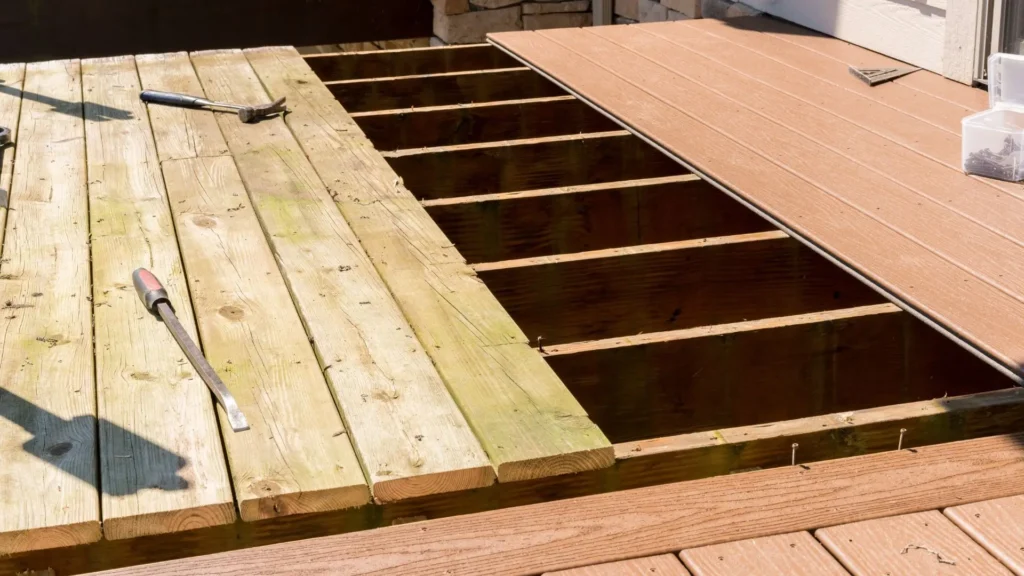
Most Popular Decking Timber Types In NZ
When planning a deck in New Zealand, choosing the right timber matters. Your choice affects how long your deck lasts, how it looks, and how much time you’ll spend maintaining it. Below are the most popular decking timber options in NZ, with a clear breakdown of their pros, cons, and best-use cases.
Pine (Treated Radiata Pine)
Pine is the most common and budget-friendly decking timber in New Zealand. It’s widely available, easy to install, and suitable for most backyard projects.
Pros:
- Affordable compared to hardwoods
- Easy to cut, shape, and install
- Can be stained or painted in any colour
- Readily available at major NZ suppliers
Cons:
- Needs regular maintenance like oiling or staining
- Less durable than hardwoods
- More prone to warping or cracking if not sealed properly
Best for:
Homeowners looking for a cost-effective deck, rental properties, and short-to-medium-term outdoor solutions.
Kwila
Kwila is a dense tropical hardwood known for its rich reddish-brown colour. It’s highly durable and holds up well in New Zealand’s weather conditions.
Pros:
- Excellent natural durability
- Rich colour and attractive grain
- Long-lasting with proper care
- Very strong and stable under foot traffic
Cons:
- Higher cost compared to pine
- Can bleed tannins, especially when wet (may stain surfaces)
- Heavier and harder to work with for DIY installs
Best for:
High-end outdoor areas, long-term builds, decks with high foot traffic, and projects where appearance matters most.
Vitex
Vitex is a pale hardwood imported mainly from the Solomon Islands. It’s gaining popularity in NZ for its soft colour tones and environmental benefits.
Pros:
- Lighter colour that weathers to a silver-grey tone
- Less oily, making it easier to stain or coat
- Good stability with minimal movement
- Often sourced from sustainable forests
Cons:
- Not as hard as other hardwoods
- May require UV protection to maintain original tone
- Slightly more expensive than pine
Best for:
Eco-conscious homeowners, minimalist designs, and decks that blend with lighter exterior themes.
Garapa
Garapa is a golden-toned hardwood that performs well in NZ’s coastal and damp regions. It’s dense and resists both decay and insect damage.
Pros:
- Naturally durable with long lifespan
- Golden appearance that fades evenly
- Less likely to bleed compared to kwila
- Withstands harsh weather
Cons:
- Can be tough to cut and drill
- Mid-to-high price range
- Requires pre-drilling to avoid splitting
Best for:
Coastal homes, seaside decks, and outdoor spaces exposed to heavy sun or rain.
Composite Timber (Bonus Option)
Composite timber is made from wood fibers and recycled plastic. While not natural timber, it’s becoming a go-to choice for homeowners wanting less upkeep.
Pros:
- Low maintenance, no need for staining or sealing
- Fade-resistant and colour-stable
- Doesn’t rot, warp, or attract insects
- Available in a variety of colours and textures
Cons:
- Higher upfront cost
- May get hotter than wood in direct sun
- Lacks the natural grain and texture of real timber
Best for:
Busy households, long-term outdoor upgrades, and anyone who wants a low-maintenance alternative to natural wood.
Choosing the right timber depends on your budget, style, and how much time you’re willing to invest in maintenance. Whether you prefer the affordability of pine, the rich finish of kwila, or the low effort of composite, each option has its place in New Zealand homes.

Timber Vs Composite: Which One Is Right For You?
Choosing between timber and composite decking in New Zealand isn’t just about looks, it’s about how well your deck will perform year after year. Both options have clear strengths, but they also come with trade-offs. Whether you’re building for your family home, a rental property, or a high-traffic area, it’s worth weighing your options carefully.
Cost
Timber is often the go-to for budget-conscious builds. Treated pine, in particular, is one of the most affordable materials on the market, making it ideal for large decks or DIY projects. You’ll typically pay less upfront for timber than composite boards.
Composite decking, on the other hand, costs more at the start. However, it can be a smart investment over time. You’ll spend less on maintenance, and it won’t need staining, painting, or oiling, ever. So while the initial price tag is higher, the long-term costs can even out.
Upkeep
Timber decks require regular care. That means annual cleaning, oiling, and checking for cracks or splinters. If neglected, timber can warp, fade, or rot, especially in New Zealand’s wet and coastal climates.
Composite decking is low-maintenance. It resists mould, moisture, and insect damage. You’ll still need to hose it down occasionally, but you won’t need to sand or reseal it. That’s why many homeowners love composite for stress-free upkeep.
Lifespan
Hardwood timbers like kwila and garapa can last 25 years or more if maintained properly. Pine decks tend to last around 15 years. Weather exposure and regular use will affect longevity.
Composite decking can last 25 to 30 years or more without fading, cracking, or splitting. It’s built to withstand harsh weather and is a great option for homes near the coast or with full sun exposure.
Appearance
Timber has a warm, natural look that’s hard to beat. Each board has unique grain patterns, knots, and textures. Over time, it weathers to a soft silver tone if left untreated, or it can maintain its color with regular oiling.
Composite mimics the look of real wood, but some people find it feels more uniform or synthetic. Still, many brands offer a wide range of colors, finishes, and textures to match your design goals.
Best Fit For Different Needs
- Families: Composite is safer for kids, no splinters, less slipping, and minimal maintenance. It’s great for barefoot play and pets too.
- Rental Properties: Composite is a clear winner here. It holds up well to tenants who may not maintain timber properly. Less maintenance also means fewer headaches for landlords.
- High-Traffic Areas: Composite is durable and dent-resistant, perfect for areas with heavy foot traffic, outdoor furniture, or frequent entertaining.
- DIY Builders: Treated pine or softwoods are easier to cut and install if you’re handling the job yourself.
If you’re after a natural look and don’t mind ongoing care, timber is a classic choice. But if you want something long-lasting with less work, composite is worth considering. Think about how much time you’re willing to spend on maintenance, how long you want your deck to last, and what fits your budget. The right choice depends on your lifestyle, and how you want your deck to perform in the long run.
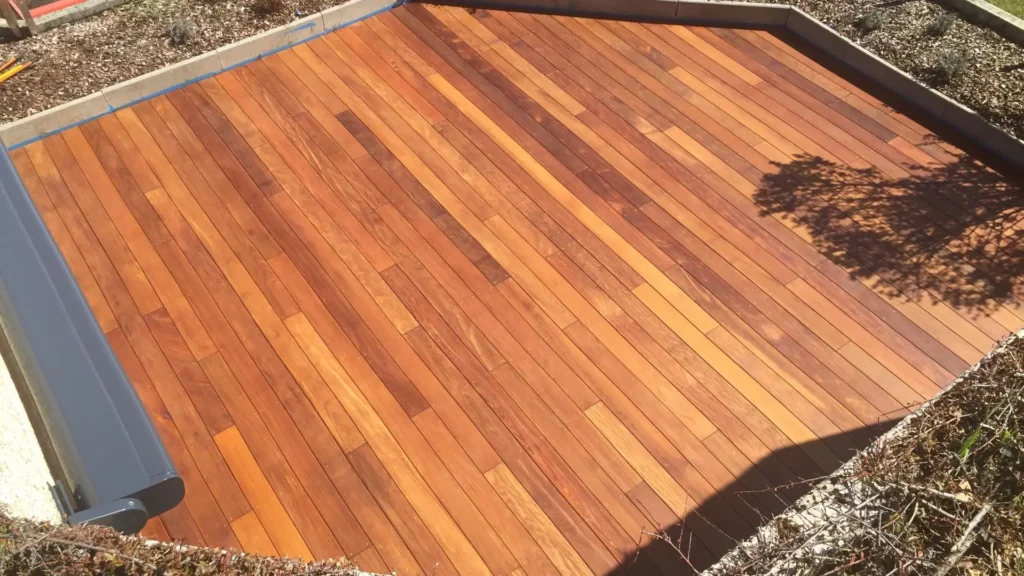
NZ Climate And Timber Choice: What To Consider
Choosing the right decking timber in New Zealand isn’t just about price or looks, it’s also about how well your deck can handle the climate where you live. NZ’s weather conditions vary widely between regions, so it’s smart to match your timber choice to your local environment. Here’s what to keep in mind before buying or building.
Wet Vs Dry Regions (North Island Vs South Island)
The North Island tends to have a warmer, more humid climate, especially in places like Auckland and Northland. This means timber here needs to resist moisture, humidity, and occasional heavy rain. Decking in these areas should be made from wood that’s treated or naturally durable, like kwila or vitex. These hardwoods are known for holding up well in damp conditions.
On the other hand, the South Island has cooler and drier areas, particularly inland regions like Central Otago. While moisture is still a concern, timber in drier climates also needs to withstand temperature swings and UV exposure. In these zones, both hardwood and well-treated pine can perform well, as long as they’re properly maintained.
Coastal Vs Inland Homes
If you live near the coast, your deck will face salty air, strong winds, and higher levels of moisture. These conditions can speed up corrosion and timber decay. For coastal homes, opt for hardwoods that resist salt and moisture, such as garapa or vitex. Stainless steel fixings and corrosion-resistant hardware are also a must in these settings.
Inland homes have more stable air quality and less salt exposure. This gives you a bit more flexibility with timber options. Treated pine can work well if the deck is protected from long-term moisture exposure. Still, regular care like oiling and sealing is key no matter where you’re located.
How Moisture And UV Exposure Affect Timber
Moisture causes timber to swell, crack, or rot if it’s not properly treated or sealed. Over time, this can lead to loose boards, surface mould, and structural damage. UV rays, especially in sunny regions, break down the timber surface and cause it to fade or splinter.
To avoid these problems, choose decking timber rated for your climate. For wet or high-humidity areas, look for H3.2 or H4 treated timber. For UV resistance, consider naturally oily hardwoods or apply a quality UV-protective oil every 6 to 12 months.
Local Council Requirements Or Codes
Some NZ councils have specific building codes for decks, especially when they’re elevated or attached to your home. You may need to meet minimum safety standards, such as using specific treatment levels (e.g., H4 for ground contact), approved fasteners, and certain balustrade heights.
Before starting your project, always check with your local council. This helps avoid fines or delays and ensures your deck is safe and compliant. Most councils have online guides or customer service lines that can walk you through what’s required.
By matching your timber choice to New Zealand’s regional climates, you’ll build a deck that not only looks great but lasts longer with less upkeep. Whether you’re by the coast or inland, in the North or South, making the right call up front saves time, money, and headaches down the line.
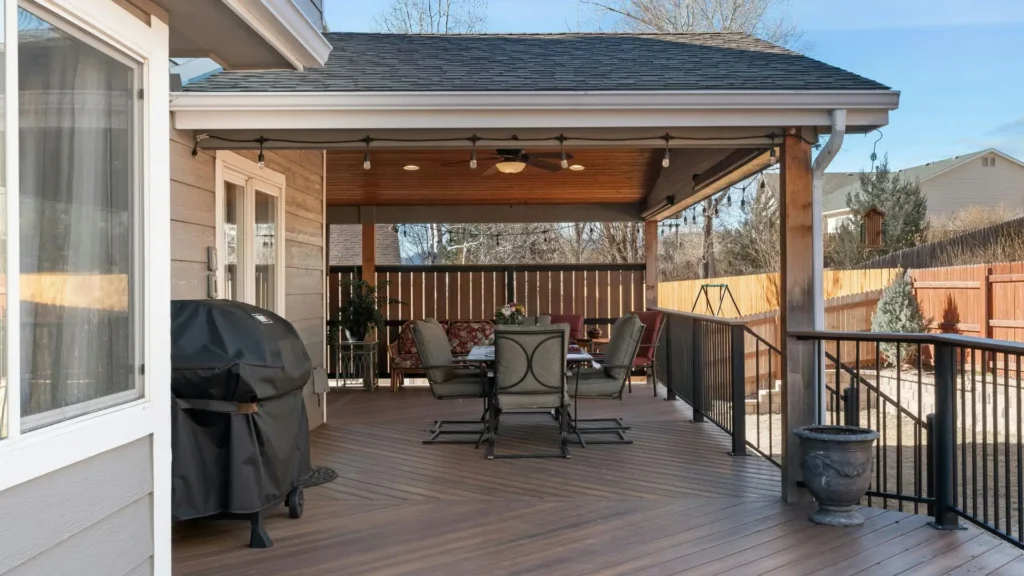
Timber Treatments And Grading Explained
When it comes to building a deck that lasts in New Zealand’s climate, timber treatment and grading are two things you can’t ignore. These factors determine how well your decking timber resists moisture, insects, and decay, and how long it will stand up to everyday wear.
Let’s break down what H3.2 and H4 treatments actually mean, why treatment is necessary, and how timber grading helps you choose quality materials for your build.
H3.2 And H4 Treatment – What They Mean
In New Zealand, treated timber is classified using hazard levels that indicate how resistant it is to rot, fungi, and insect attack. These levels are regulated by NZ standards and are often printed directly on the timber itself.
- H3.2 Treated Timber:
This is suitable for timber that will be exposed to the weather but not in contact with the ground. It’s perfect for above-ground decking boards. H3.2 treatment protects against rot, fungal decay, and insect damage, making it a common choice for residential decks. - H4 Treated Timber:
H4 is designed for timber that will be in contact with the ground, such as deck posts, bearers, and joists. It offers a higher level of protection because ground moisture increases the risk of rot and termite attack. H4 timber is often used as the foundation for raised or ground-level decks.
Choosing the correct treatment level is not optional, it ensures your deck complies with safety standards and lasts for years without structural failure.
Why Treatment Matters For Durability And Safety
New Zealand’s weather can be tough on timber. From heavy rain and humidity to strong sun and salty air, untreated or poorly treated wood won’t survive long. Here’s why proper treatment is critical:
- Prevents Rot And Decay:
Untreated timber is highly vulnerable to moisture. Even short-term exposure can cause rot, weakening the structure and reducing lifespan. - Protects Against Insects:
Termites, borers, and other insects can quickly destroy untreated wood. Treated timber repels these pests and protects your deck from internal damage. - Improves Safety:
A rotting or unstable deck is dangerous. Treatment helps maintain structural integrity over time, especially in high-use areas like stairs, handrails, and platforms. - Compliance With NZ Building Code:
Councils and building inspectors require specific treatment levels for different parts of a deck. Using the wrong type of timber could mean failed inspections or costly rebuilds.
Timber Grading: How To Know You’re Getting Quality
Not all timber is equal. Even with proper treatment, the quality of the wood itself matters. That’s where timber grading comes in.
Timber in New Zealand is graded based on its appearance and structural strength:
- Visual Grade:
This refers to the appearance of the timber. A higher visual grade has fewer knots, better grain alignment, and smoother surfaces. These are ideal for visible deck surfaces where look and finish matter. - Structural Grade:
This focuses on strength. Graded by machine or certified inspectors, structural-grade timber is used for support beams, bearers, and joists. It ensures the deck can hold weight without sagging or shifting. - Premium Decking Timber:
When buying hardwoods like kwila or garapa, check for premium or select-grade labels. These timbers offer both visual appeal and high strength, making them ideal for long-lasting, good-looking decks.
To avoid low-quality timber:
- Buy from reputable NZ suppliers.
- Check treatment stamps (e.g., H3.2 or H4).
- Ask for grade certification, especially for structural components.
Choosing the right timber treatment and grade isn’t just a technical step, it’s a smart way to protect your investment and ensure your deck stands the test of time. Whether you’re hiring a builder or going DIY, always check the labels and ask the right questions before you buy.
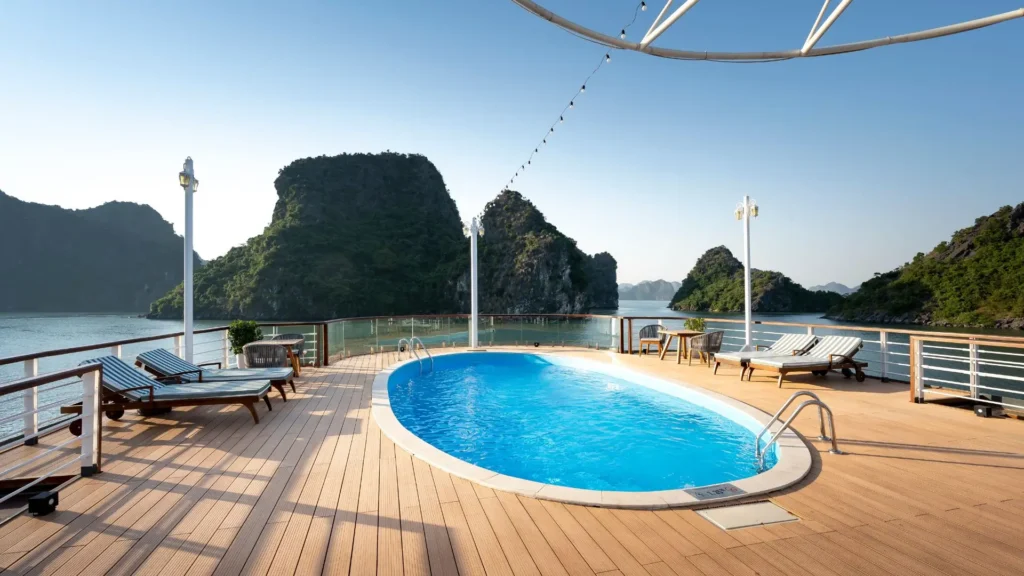
Cost Breakdown: What To Expect
Building a deck is an investment, and understanding the full cost breakdown helps you plan better and avoid surprises. In New Zealand, decking costs vary depending on the timber type, installation method, and long-term upkeep. Here’s a clear look at what to expect when budgeting for your new deck.
Price Range For Different Timber Types
Timber prices in NZ can vary based on the type of wood, treatment level, and supplier location. Below are average cost ranges per lineal metre:
- Treated Pine (Radiata Pine H3.2 or H4): $3 to $6
Affordable and easy to work with. Ideal for budget builds but needs regular maintenance. - Kwila: $10 to $15
A dense hardwood with excellent durability and rich color. More expensive but long-lasting. - Vitex: $9 to $13
A popular light-toned hardwood that weathers nicely and offers a clean finish. - Garapa: $11 to $14
A golden hardwood known for its durability and smooth texture. Resists fading and staining. - Composite Decking: $12 to $18
Not real timber but worth mentioning. Offers low maintenance and long-term performance.
These are base material prices only. Longer or wider boards, special cuts, and higher-grade timber can increase costs.
Installation Vs DIY Costs
Professional installation is the most convenient but adds a significant amount to your budget. On average, expect to pay:
- $300 to $500 per square metre for a fully installed timber deck.
- Price includes timber, framing, fasteners, and labor.
DIY installation can reduce costs by 40% or more, especially for ground-level decks. However, you’ll still need to factor in:
- Tools (power saw, drill, level, etc.)
- Fixings and hardware
- Delivery fees
- Time and effort
If you’re confident with tools and have the time, a DIY deck can be a smart way to save.
Maintenance Costs Over Time
Timber decking requires ongoing care, which adds to the lifetime cost of your deck. Here’s what to expect:
- Oils or stains: $40 to $80 per 4L can (covers 20–30 square metres)
- Cleaning products: $15 to $30 for deck cleaners
- Tools for maintenance: Brushes, rollers, or spray systems can add $20 to $50
You’ll need to clean and oil your deck at least once a year. Hardwood decks may need less frequent attention than pine, but skipping maintenance shortens their life and increases long-term repair costs.
Tips For Saving Without Cutting Corners
- Buy in bulk: Ordering all timber and hardware at once can reduce delivery fees and score discounts.
- Choose standard sizes: Custom cuts and rare timber types cost more.
- Stick to ground-level designs: Raised decks require more framing and council approvals.
- Use hidden fasteners only where it matters: They’re visually appealing but more expensive.
- Source timber locally: Reduces transport fees and supports nearby businesses.
By knowing what to expect and making smart choices, you can build a deck that fits your budget without compromising quality or durability. Make sure to plan for both the upfront cost and the ongoing care, because a well-maintained deck adds value to your home and enjoyment to your lifestyle.
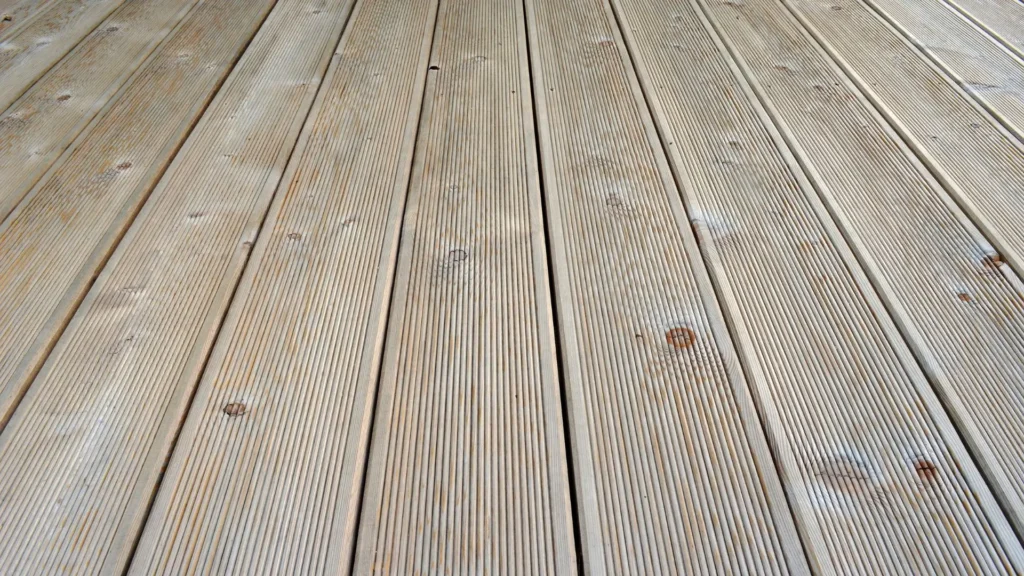
How To Maintain Your Decking Timber
Keeping your decking timber in great condition doesn’t need to be difficult, but it does require consistency. In New Zealand’s unpredictable climate, moisture, UV rays, and foot traffic can take a toll on your deck if you skip regular maintenance. Whether you’re dealing with treated pine or premium hardwoods like kwila or vitex, the care process is similar. Below is a complete, easy-to-follow guide to help you protect your investment and keep your deck looking its best year-round.
Basic Care Routine: Cleaning, Oiling, And Re-Staining
- Clean Your Deck Regularly
Dirt, leaves, mold, and algae can build up quickly, especially during autumn and winter. Sweep your deck weekly to prevent buildup in corners and between boards. Once every few months, give it a proper clean using a soft-bristle broom and a timber-safe deck cleaner mixed with warm water. - Apply Decking Oil Or Stain
Oiling or staining your deck enhances the timber’s natural color and helps protect it from moisture and UV damage. Reapply oil or stain once or twice a year depending on the timber type and exposure to sun or rain. Make sure the deck is dry and clean before applying anything. - Inspect For Damage
Look for cracks, lifted boards, or rusting nails. Catching small issues early can prevent costly repairs later. Sand down any splinters and tighten loose screws.
Seasonal Tips For NZ Homeowners
- Spring:
Clear away debris left from winter. Clean the surface and inspect for moisture damage. Spring is the perfect time to apply a fresh coat of oil or stain before the hot weather sets in. - Summer:
High UV exposure can fade timber quickly. Make sure your deck is protected with a UV-resistant finish. If the deck is in full sun, consider using shade sails or outdoor rugs to reduce wear. - Autumn:
Sweep often to remove falling leaves. Organic matter holds moisture and can cause mold growth. Avoid letting leaves sit between the boards. - Winter:
Keep the deck dry when possible. Water and frost can cause expansion, splitting, and warping. Don’t store firewood or furniture directly on timber for long periods.
Common Mistakes To Avoid
- Pressure Washing Too Hard
A common mistake is blasting the deck with a high-powered water jet. While it might seem efficient, too much pressure can damage the timber surface, remove protective oils, and raise the grain. Use a moderate-pressure setting or a garden hose with a deck brush. - Ignoring Drainage
Poor water runoff can cause pooling, which leads to rot. Check that water doesn’t sit on your deck after rain. If it does, you may need to adjust the slope or unblock the gaps between boards. - Skipping Regular Maintenance
Waiting too long between oiling or staining allows the timber to dry out and crack. It’s easier and cheaper to maintain timber annually than to fix weathered boards later. - Using Harsh Chemicals
Avoid bleach or strong detergents that can strip natural oils from the timber. Always use products labeled as safe for wooden decking.
By following these practical steps, your deck will stay strong, safe, and good-looking for many years. Good maintenance also adds long-term value to your home, especially if you’re in areas with high humidity or direct sunlight. Make it part of your routine, and your deck will thank you for it.
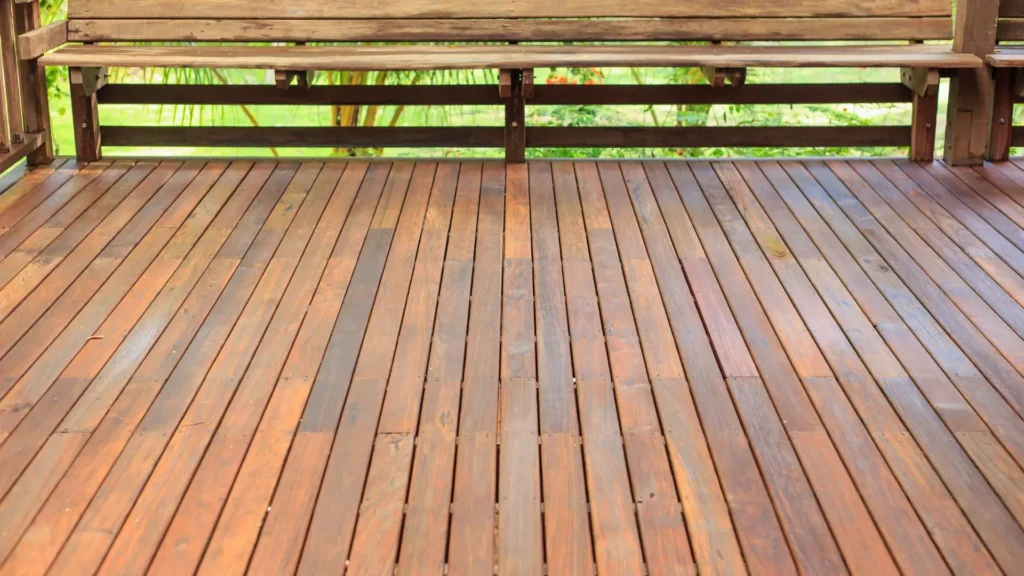
Where To Buy Decking Timber In NZ
When you’re ready to buy decking timber in NZ, you’ll find plenty of choices, both nationwide retailers and local timber merchants. The right supplier depends on your budget, the type of timber you want, and how much support you need before and after your purchase. Let’s look at your options so you can make a smart and confident choice.
Major Suppliers Across New Zealand
If you want convenience and consistent stock levels, big box stores are a good starting point. Here are four of the most well-known suppliers:
- Mitre 10 – One of NZ’s largest home improvement chains. Mitre 10 carries a wide range of treated pine and hardwood decking. Many stores offer timber cutting services and advice for DIYers.
- Bunnings Warehouse – Known for competitive pricing and nationwide reach. Bunnings stocks everything from pine to composite decking, plus all the tools, fasteners, and stains you’ll need for your project.
- ITM (Independent Timber Merchants) – A network of locally owned stores with a strong focus on building materials. ITM is popular with tradies and often carries high-grade timber suited to NZ conditions.
- PlaceMakers – A trade-focused supplier with a wide range of timber and decking materials. PlaceMakers offers great support for larger jobs and has knowledgeable staff who understand construction standards.
These stores are ideal if you want easy access to materials, clear pricing, and fast pickup or delivery.
Local Timber Merchants Vs Big Box Stores
Local timber yards and specialty merchants often fly under the radar, but they offer strong advantages, especially if you’re looking for quality and expert advice.
- Local merchants often source from regional mills, which means you might get better timber suited to your area’s weather.
- You can ask more specific questions about timber grading, moisture content, and treatment levels, things that are sometimes hard to clarify in big chains.
- Bulk pricing may be more flexible, especially if you’re buying for a larger job or want a custom cut.
Big box stores win on convenience and one-stop shopping, but local timber yards win on quality and service. If you’re building a high-end deck or working with a builder, it’s worth comparing both.
Why Sourcing Timber Locally Can Help
Buying from a local supplier comes with benefits that go beyond just the timber itself.
- Faster delivery times – Less waiting, fewer delays.
- Better after-sales support – If you need more timber or run into issues, local suppliers can often respond quickly.
- Local knowledge – Some timbers perform better in coastal or alpine areas. A local merchant understands what works best in your region and can steer you toward the right choice.
- Support for NZ businesses – You’re also helping your community and local economy by keeping your dollars close to home.
No matter where you choose to buy, take time to inspect the timber quality, ask about warranties or return policies, and make sure it matches your decking plans. A few good questions upfront can save you a lot of time and money later.
Thinking about building a deck? Visit us to explore quality decking timber options trusted by homeowners across NZ.

FAQs: About Decking Timber In NZ
What is the best decking timber in NZ?
The best decking timber in NZ depends on your needs. Treated pine is affordable and widely available, while hardwoods like kwila and vitex offer better durability and a richer appearance. Composite timber is also a strong option for low maintenance.
How long does timber decking last in New Zealand?
Timber decking in NZ can last 15–25 years or more with proper care. Hardwood timbers like kwila and garapa tend to last longer than pine. Regular oiling, cleaning, and weather protection extend lifespan significantly.
Is treated pine good for decking?
Yes, treated pine (usually H3.2 or H4) is commonly used for decking in NZ. It’s affordable, easy to work with, and suitable for most environments. However, it needs regular staining or oiling to prevent early wear.
What is the difference between kwila and vitex decking?
Kwila is a dense, reddish hardwood with excellent durability but may bleed tannins. Vitex is lighter in color, easier to work with, and has a more neutral tone. Both are popular hardwoods in NZ, but vitex is often preferred for eco-friendly builds.
Do I need council approval to build a deck in NZ?
In most cases, you don’t need council consent if the deck is under 1.5 meters high. However, it’s best to check with your local council as rules can vary depending on your location and property.
How much does decking timber cost in NZ?
Treated pine costs around $3–$6 per meter, while hardwoods like kwila range from $10–$15 per meter. Composite decking can start at $12 per meter and go higher based on brand and quality. Prices vary by region and supplier.
Is composite decking better than timber?
Composite decking offers low maintenance and long lifespan, but it’s more expensive upfront. Timber decking has a natural look and feel, and it can be more cost-effective if maintained well. The better choice depends on your budget and style preferences.
How do I maintain my timber deck in NZ?
Maintenance involves regular cleaning to remove dirt and moss, oiling or staining once or twice a year, and inspecting for cracks or loose boards. Avoid pressure washing too harshly, and trim nearby plants to improve airflow and reduce moisture buildup.
Can I install a timber deck myself?
Yes, many homeowners in NZ choose to DIY their decks, especially with pine timber. It helps to have basic carpentry skills, the right tools, and a clear plan. For hardwood or raised decks, hiring a professional may be the better option.
Where can I buy decking timber in NZ?
You can find decking timber at major stores like Mitre 10, Bunnings, ITM, and PlaceMakers. Local timber yards may offer better quality or pricing, especially for hardwoods. Always compare prices and ask about treatment grades before buying.
Conclusion
Choosing the right decking timber in NZ comes down to your climate, budget, and how much time you’re willing to spend on maintenance. Whether you go with cost-effective pine, long-lasting hardwoods like kwila or vitex, or even low-maintenance composite, each option has its place depending on your needs. With proper planning, treatment, and upkeep, your deck can handle New Zealand’s weather and provide a durable, attractive space for years.

